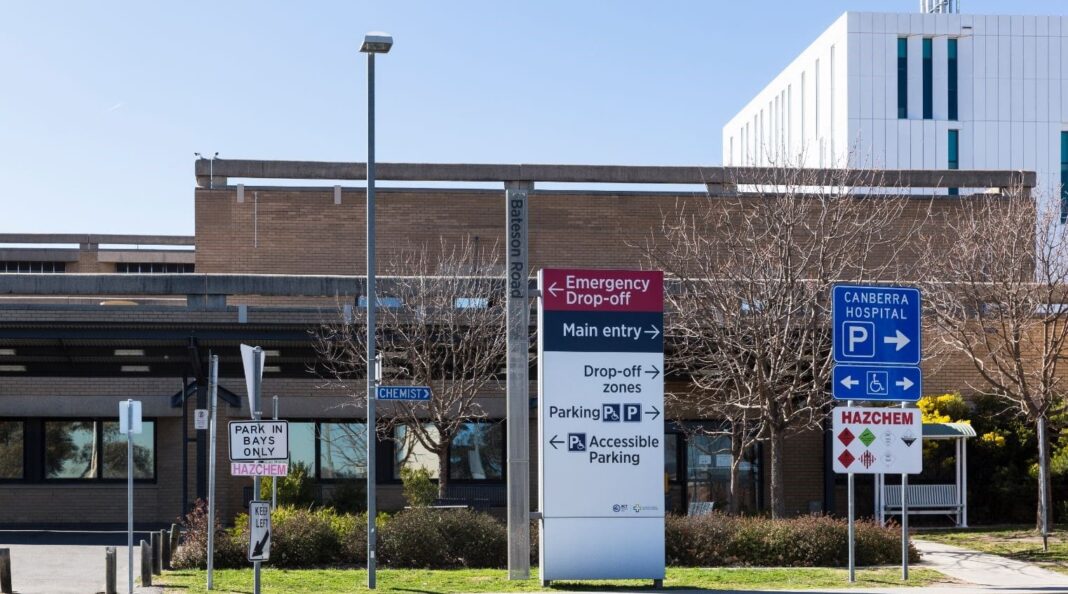Canberra patients are well pleased with the hospital care they receive, it seems – once they finally see somebody.
More than 95% of patients at Canberra Health Services and Calvary Hospital provided positive feedback, according to an inpatient experience survey printed in the ACT Public Health Service’s quarterly report. But the ACT also has the longest waiting times in the country, the Australian Institute of Health and Welfare report into emergency department care (released yesterday) revealed.
Half the patients are seen within 44 minutes, half an hour longer than the national median waiting time of 17 minutes. 90% of patients are seen within 2 hours 47 minutes, an hour and a quarter behind the national figure of 92 minutes. And only 48% of patients are seen on time, well below the national average of 74%.
ACT Health’s own quarterly report notes that 70.1% of patients received treatment within the clinically recommended time for their triage – which means three in 10 (29.9%) did not.
The Canberra Liberals have taken the Labor/Greens Government to task. Giulia Jones, Shadow Minister for Health, said:
“For a government that has been in power for almost 20 years, this simply isn’t good enough. [Minister for Health Rachel Stephen-Smith] must explain how she will turn this appalling situation around, and demonstrate how this city will become better than average, befitting of the nation’s capital. The same old excuses and assurances no longer cut it.”
But the figures may not be so simple, Ms Stephen-Smith argues.
“It’s not an apple-to-apples comparison,” she said on Thursday. “[The ACT] is unlike any other jurisdiction.”
The ACT is a small jurisdiction, Ms Stephen-Smith said, but 25% of its patient load comes from surrounding NSW – invariably a higher acuity patient load of people with significant injuries and illnesses. Nor does the ACT have the mixture of busy metropolitan hospitals (comparable to those here) and small general hospitals with little waiting time found in other states.
But Ms Stephen-Smith admitted that compared to its peer hospitals, the ACT was “not doing as well as we should be”.
This week, Canberra Hospital was unable to cope with a record number of patients, and was forced to send patients to Calvary. The same occurred in November. A spokesperson this week said the high number of patients unable to return home created a backlog. Other contributing factors included high pollen counts provoking respiratory conditions, and more mental health cases presenting to emergency departments.
The ACT had kept up with population growth, Ms Stephen-Smith said; it had the same number of beds per population it did a decade ago. The University of Canberra Hospital, open in 2018, provided 140 more beds.
Calvary Hospital had expanded its emergency department this year, adding 14 ‘see and treat’ spaces and eight more short-stay beds – increasing emergency department treatment spaces by 20% across the system. Refurbishing a ward at Canberra Hospital will add 10 more mental health beds, Ms Stephen-Smith said.
The crux was good patient flow, the Minister argued. “It’s about getting people through the emergency department and into a ward if they need to be admitted, or through the emergency department in a good treatment time if they’re going to be admitted and then go home. If we can get that bit right, we can actually manage the number of people who are presenting at the emergency department.”
ACT Health was trying to change the process and the culture at the emergency departments to make them more efficient, but doing so in “a busy 24/7 operation” was difficult, Ms Stephen-Smith said.
Canberra Health Services will set benchmarks for the next three, six, and nine months, and measure itself against those benchmarks, she said. They will also trial measures adopted by other major Australian hospitals.
Over recent weeks, for instance, Canberra Hospital has established a process where emergency department consultants can directly admit patients into the appropriate ward, rather than waiting for a consultant or registrar to come down to the emergency department to agree to the admission, Ms Stephen-Smith said. The hospital’s discharge lounge also freed beds for patients.
“No, it’s not going to turn around overnight; I can’t promise Canberrans that,” she said. “What I can promise them is that we have a clear strategy across both the hospital and the emergency department to see these figures reduce; we will continue to implement that strategy; and we will continue to measure our outcomes.”
Ms Stephen-Smith advised Canberrans to consider other options than emergency departments.
Walk-in centres in Belconnen, Dickson, Gungahlin, Tuggeranong, and Weston Creek offer free health care for non-life threatening injuries and illnesses (including cuts, bruises, burns, strains, sprains, and minor limb fractures). Making an appointment with a GP could also be appropriate. The ACT Health app also provided information on wait times, treatment times, locations, and travel directions.
For more news:



